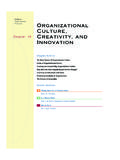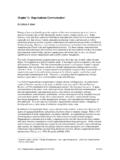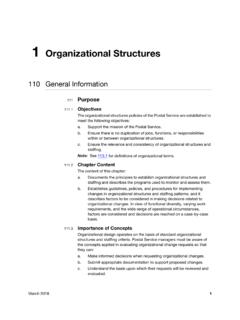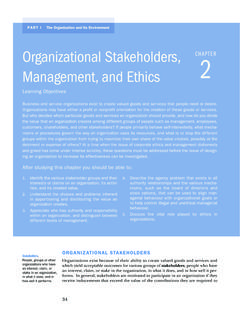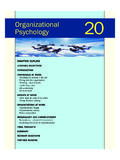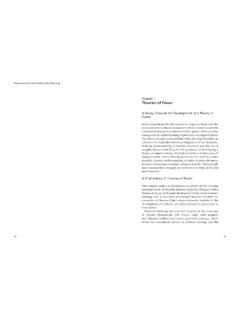Transcription of Building Organizational Change Capability
1 C H A P T E R. 5. Building Organizational Change Capability Your s uccess i n l ife is n't base d o n yo ur a bility t o s imply c hange. It is base d on your a bility to cha nge fa ster tha n y our com petition, c ustomers a nd business. Mark Sanborn B y taking a more thoughtful and disciplined approach to Change , conscious Change le aders na turally b egin t o addr ess ho w t hey ca n im prove t heir organization's c hange Capability . Their mo tivation is ob vious: If we can pro- actively increase our results in t his Change effort using these approaches, why don't we do s o for all o ur changes for the years to come?
2 They begin to real- ize that strong Change Capability is vi tal to their organizations' near-term and long-term success, a nd t hey start to lo ok for ways to build t hat Capability . In this chapter , we will exp lore how approaching Change as a stra tegic discipline is k ey t o b uilding y our o rganization's c hange Capability . This me ans no t o nly Building your leaders' and internal consultants' knowledge and skills b ut also the Organizational systems and infrastructure that will enable Change to be led more effectively and consistently. 106. 106 8/19/10 9:33:34 AM. Change Capability : A KEY TWENTY-FIRST.
3 CENTURY COMPETITIVE ADVANTAGE. Organizations that excel at Change have a co mpetitive advantage. ey cap- ture market opportunities; significantly improve their operations; innovate, merge, downsize, rebrand, grow, restructure, acquire, and implement new products, ser- vices, and technologies; improve their supply chain; and perform numerous other critical activities better than their competitors who struggle with Change . Change Capability est ablishes t he co re co mpetency o f improving j ust a bout every aspect of business performance. Conscious Change leaders understand this and recognize the importance of Building their organizations' Change capabilities.
4 Change Capability is the ability of an organization to plan, design, and imple- ment all types of Change efficiently with committed stakeholders, causing minimal negative impacts on people and operations, so that desired business and cultural results from Change are consistently achieved and integrated seamlessly into opera- tions to deliver maximum ROI. Figure sho ws ho w b uilding c hange ca pability p ositively im pacts y our organization. In the diagram, A Work denotes your core business activities, that is, everything your organization does to provide value to customers. B Work is all of Figure The Impact of Change Capability A Core Business Activities: Business WORK processes, systems, technology, and so on.
5 Change Efforts: Techniques, methodologies and strategies B to improve the organization's A work;. WORK all Change programs and projects intended to improve Organizational performance Change Capability : Techniques, C methodologies, and strategies to improve WORK the organization's B work; Improving the way in which we Change and improve the work of the organization Building Organizational Change Capability 107. 107 8/19/10 9:33:46 AM. the Change efforts you put into improving A Work, making you or your organiza- tion the best it can be. C Work is im proving your ability to do B W ork, in o ther words, improving your ability to improve, to Change .
6 C Work is consciously build- ing Change Capability so you continually improve the results you get from Change . Remember the statistic of the 60 70 percent failure rate from Change ? C Work stops the failure and delivers Change results. Building Change Capability requires commitment, resources, and time. It starts with increasing executive, management, and employee Change knowledge and skills. Executives must learn how to sponsor Change effectively. Change process leaders and Change team members must develop solid competence in planning, designing, and implementing Change . Managers must learn how to facilitate Change in t heir operational areas, including how to engage employees to build commitment and ownership of the changes.
7 Workers must learn how to adapt to Change , make the changes relevant to them, and contribute to successful outcomes. is r equires a s erious co mmitment t o tra ining a nd de velopment, inc lud- ing real-time Change project application t hat goes b eyond t he typical classroom. Action le arning a nd o ngoing f eedback a re cr itical. C ommunities o f p ractice a re vital for coaching, mentoring, and sharing best practices. All of this development will improve your track record in le ading Change , but a most im portant action is positioning Change as a strategic discipline in your organization. Change : THE NEW STRATEGIC DISCIPLINE.
8 Virtually all key functions in organizations strategy, finance, marketing, sales, human resources, and information technology are set up as strategic disciplines to ensure they function consistently at the highest levels possible. ese disciplines, and the management protocols that go with them, are crucial to these business functions performing effectively. In today's organizations, Change is as mission-critical as these other key f unctions and must b e embraced as suc h. Ot herwise, t he approaches to Building Change Capability will be superficial, temporary, and piecemeal, and not pro- duce the sponsorship, resources, or operational excellence required.
9 We have identified five key strategies so far to creating Change as a strategic dis- cipline: (1) identifying and managing an enterprise Change agenda; (2) having one common c hange process met hodology; (3) es tablishing a c hange infrastructures;. (4) b uilding a stra tegic c hange cen ter o f excellence f or all c hange p ractitioners;. and (5) creating a strategic Change office. We will describe each in order, although 108 Beyond Change Management 108 8/19/10 9:33:49 AM. sequence is not implied here. You will quickly see that they fit together as an inte- grated approach, where the fifth strategy, the strategic Change office, runs all of them.
10 Read each description first for understanding, and then consider the possibility for creating each in your organization. You may find that your leaders have an appetite for one or more of t he dis ciplines; build f rom t here a fter value is demo nstrated. Creating a nd mast ering all o f t hese stra tegies ca n e asily b e a t hree- t o five -year undertaking. (See premium content: Building Change Capability : Leading Change as a Strategic Discipline; ). As w e exp lore e ach strategy, imagine y our organization bringing t o c hange a similar level of resources, organization, and strategic attention that it currently gives to finance, IT, and HR.

